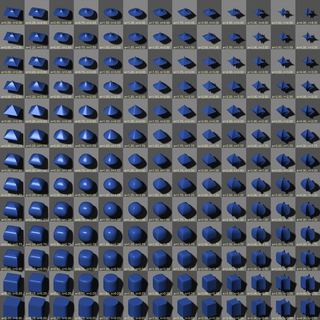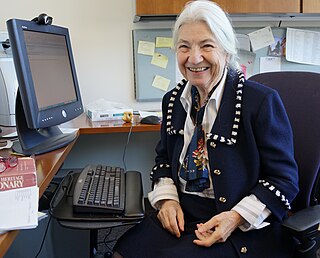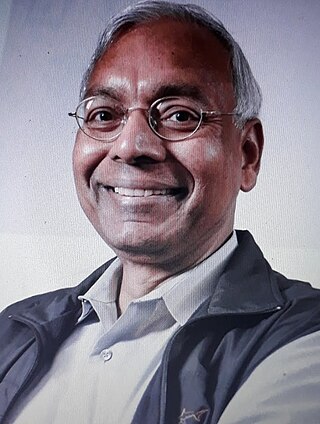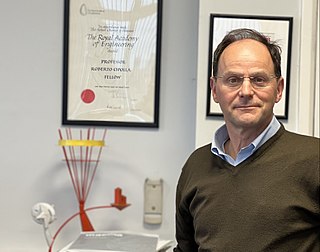
The University of Ljubljana, abbreviated UL, is the oldest and largest university in Slovenia. It has approximately 38,000 enrolled students. The university has 23 faculties and three art academies with approximately 4,000 teaching and research staff, assisted by approximately 2,000 technical and administrative staff. The University of Ljubljana offers programs in the humanities, sciences, and technology, as well as in medicine, dentistry, and veterinary science.

In mathematics, the superquadrics or super-quadrics are a family of geometric shapes defined by formulas that resemble those of ellipsoids and other quadrics, except that the squaring operations are replaced by arbitrary powers. They can be seen as the three-dimensional relatives of the superellipses. The term may refer to the solid object or to its surface, depending on the context. The equations below specify the surface; the solid is specified by replacing the equality signs by less-than-or-equal signs.

Bežigrad Grammar School or Bežigrad Gymnasium is a selective coeducational state secondary school. It is named after the Bežigrad district in Ljubljana, Slovenia, where it is located.

Linda G. Shapiro is a professor in the Department of Computer Science and Engineering, a professor of electrical engineering, and adjunct professor of Biomedical Informatics and Medical Education at the University of Washington.
Range segmentation is the task of segmenting (dividing) a range image, an image containing depth information for each pixel, into segments (regions), so that all the points of the same surface belong to the same region, there is no overlap between different regions and the union of these regions generates the entire image.

In mathematics, a superellipsoid is a solid whose horizontal sections are superellipses with the same squareness parameter , and whose vertical sections through the center are superellipses with the squareness parameter . It is a generalization of an ellipsoid, which is a special case when .

Ruzena Bajcsy is an American engineer and computer scientist who specializes in robotics. She is professor of electrical engineering and computer sciences at the University of California, Berkeley, where she is also director emerita of CITRIS.

Jitendra Malik is an Indian-American academic who is the Arthur J. Chick Professor of Electrical Engineering and Computer Sciences at the University of California, Berkeley. He is known for his research in computer vision.

The Embassy of Slovenia in Washington, D.C. is the Republic of Slovenia's diplomatic mission to the United States. The embassy in Washington is also responsible for representing Slovenia in Mexico. The chancery is located just off Embassy Row at 2410 California Street NW in the Kalorama neighborhood. Consular assistance is also provided by Slovenia's network of consulates in the U.S. and Mexico.
Active perception is the selecting of behaviors to increase information from the flow of data those behaviors produce in a particular environment. In other words, to understand the world, we move around and explore it—sampling the world through our senses to construct an understanding (perception) of the environment on the basis of that behavior (action). Within the construct of active perception, interpretation of sensory data is inherently inseparable from the behaviors required to capture that data. Action and perception are tightly coupled. This has been developed most comprehensively with respect to vision where an agent changes position to improve the view of a specific object, or where an agent uses movement to perceive the environment.

Anil Kumar Jain is an Indian-American computer scientist and University Distinguished Professor in the Department of Computer Science & Engineering at Michigan State University, known for his contributions in the fields of pattern recognition, computer vision and biometric recognition. He is among the top few most highly cited researchers in computer science and has received various high honors and recognitions from institutions such as ACM, IEEE, AAAS, IAPR, SPIE, the U.S. National Academy of Engineering, the Indian National Academy of Engineering and the Chinese Academy of Sciences.

Theodosios Pavlidis is a computer scientist and Distinguished Professor Emeritus of Computer Science at the State University of New York, Stony Brook.

René Vidal is a Chilean electrical engineer and computer scientist who is known for his research in machine learning, computer vision, medical image computing, robotics, and control theory. He is the Herschel L. Seder Professor of the Johns Hopkins Department of Biomedical Engineering, and the founding director of the Mathematical Institute for Data Science (MINDS).

Scene text is text that appears in an image captured by a camera in an outdoor environment.
Jana Košecká is a Slovak computer scientist specializing in computer vision. She is a professor of computer science at George Mason University. Previously, Košecká was a researcher at Stanford University and the University of California, Berkeley.
Aleš Leonardis is professor of computer and information science at the University of Birmingham and at the University of Ljubljana. He is also an adjunct professor at the Faculty of Computer Science of the Graz University of Technology and a former visiting researcher of the Laboratory at the University of Pennsylvania, postdoc of TU Wien and visiting professor at ETH Zurich.
Song-Chun Zhu is a Chinese computer scientist and applied mathematician known for his work in computer vision, cognitive artificial intelligence and robotics. Zhu currently works at Peking University and was previously a professor in the Departments of Statistics and Computer Science at the University of California, Los Angeles. Zhu also previously served as Director of the UCLA Center for Vision, Cognition, Learning and Autonomy (VCLA).

Roberto Cipolla, FREng, is a British researcher in computer vision and Professor of Information Engineering at the University of Cambridge.
Gérard G. Medioni is a computer scientist, author, academic and inventor. He is a vice president and distinguished scientist at Amazon and serves as emeritus professor of Computer Science at the University of Southern California.













